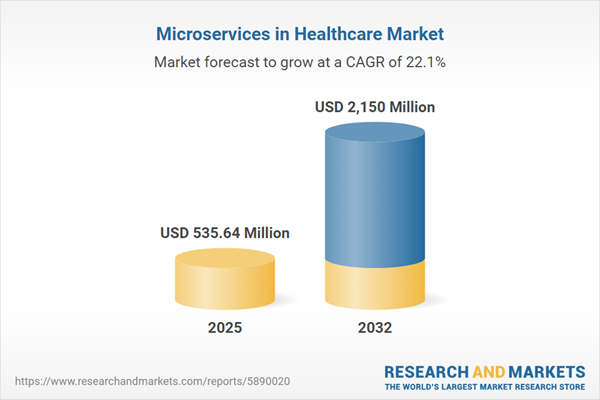Speak directly to the analyst to clarify any post sales queries you may have.
The microservices in healthcare market is redefining how medical IT solutions are developed, integrated, and scaled. Senior decision-makers seeking operational agility, regulatory alignment, and competitive differentiation are turning to microservices as the backbone of healthcare digital transformation.
Market Snapshot: Microservices in Healthcare Market Growth
The Microservices in Healthcare Market grew from USD 437.10 million in 2024 to USD 535.64 million in 2025. It is expected to continue growing at a CAGR of 22.06%, reaching USD 2.15 billion by 2032. This expansion reflects robust adoption by organizations seeking greater application scalability, strong interoperability, and the ability to innovate rapidly. Market growth is underpinned by demand for technology that enables seamless integration of diverse health IT systems and supports the modernization of both patient-facing and clinical operations.
Scope & Segmentation
- Deployment Model: On Premises; On-Cloud.
- Application Areas: Billing and Claims Management; Electronic Health Records (including Inpatient and Outpatient); Medical Imaging (Cardiology Imaging, Pathology Imaging, Radiology); Remote Patient Monitoring; Telemedicine.
- Service Types: API Management (Analytics, Developer Portal, Gateway); Orchestration; Service Discovery; Service Mesh (Control Plane, Data Plane).
- End User Profiles: Clinics (General Practices, Specialty Clinics); Hospitals (Community Hospitals, Tertiary Care); Pharmaceutical Companies; Research Laboratories.
- Regional Coverage: Americas (US, Canada, Mexico, Brazil, Argentina, Chile, Colombia, Peru); Europe, Middle East & Africa (UK, Germany, France, Russia, Italy, Spain, Netherlands, Sweden, Poland, Switzerland, United Arab Emirates, Saudi Arabia, Qatar, Turkey, Israel, South Africa, Nigeria, Egypt, Kenya); Asia-Pacific (China, India, Japan, Australia, South Korea, Indonesia, Thailand, Malaysia, Singapore, Taiwan).
- Key Companies: Amazon Web Services, Microsoft, Google, IBM, Oracle, Red Hat, VMware, Salesforce, TIBCO, Software AG.
Key Takeaways for Decision-Makers
- Microservices architecture empowers healthcare organizations to modernize legacy IT, enabling rapid deployment of new features and seamless system upgrades.
- Cloud-based and hybrid deployment models facilitate flexible resource allocation and cost optimization, catering to institutions with differing infrastructure and regulatory needs.
- Segment-specific adoption is driven by electronic health record modernization, imaging analytics, and remote patient monitoring, broadening the impact across both clinical and administrative workflows.
- Enhanced interoperability via standardized APIs and protocols like FHIR reduces integration risk with external partners and fosters secure data exchange.
- Sector leaders are leveraging strategic partnerships among cloud vendors, software developers, and healthcare providers to accelerate migration, optimize workflows, and achieve regulatory compliance efficiently.
- Regional variations in adoption are shaped by factors such as regulatory frameworks, health IT infrastructure maturity, and cloud readiness, with North America and Asia-Pacific displaying dynamic growth.
Tariff Impact: Navigating Cost Structures in 2025
Recent US tariffs targeting imported data center hardware and network appliances are reshaping procurement strategies and cost models for healthcare microservices. Providers are mitigating cost pressures through alliances, joint sourcing agreements, and migration to domestically-hosted or lightweight container services. These measures help offset increased expenses and enhance supply chain resilience, especially for organizations with hardware-dependent architectures.
Methodology & Data Sources
This report applies a blend of primary interviews—featuring insights from healthcare technology leaders, architects, and clinicians—with in-depth secondary research across journals, regulatory updates, and industry white papers. Data triangulation and expert validation ensure accuracy and timely analysis of current microservices adoption trends and strategic developments.
Why This Report Matters
- Offers strategic clarity on technology investments by mapping deployment models and service types aligned with evolving operational and compliance needs.
- Provides actionable industry benchmarks and best practices to support efficient microservices migration and governance.
- Illuminates regional nuances, helping executives tailor strategies to local market dynamics and anticipate regulatory, operational, or tariff-related shifts.
Conclusion
Adopting microservices accelerates healthcare innovation and strengthens institutional resilience. This report delivers essential insights to help decision-makers achieve regulatory alignment, performance goals, and sustained growth in a transforming healthcare landscape.
Additional Product Information:
- Purchase of this report includes 1 year online access with quarterly updates.
- This report can be updated on request. Please contact our Customer Experience team using the Ask a Question widget on our website.
Table of Contents
3. Executive Summary
4. Market Overview
7. Cumulative Impact of Artificial Intelligence 2025
Companies Mentioned
The companies profiled in this Microservices in Healthcare market report include:- Amazon Web Services, Inc.
- Microsoft Corporation
- Google LLC
- International Business Machines Corporation
- Oracle Corporation
- Red Hat, Inc.
- VMware, Inc.
- Salesforce.com, Inc.
- TIBCO Software Inc.
- Software AG
Table Information
| Report Attribute | Details |
|---|---|
| No. of Pages | 195 |
| Published | November 2025 |
| Forecast Period | 2025 - 2032 |
| Estimated Market Value ( USD | $ 535.64 Million |
| Forecasted Market Value ( USD | $ 2150 Million |
| Compound Annual Growth Rate | 22.0% |
| Regions Covered | Global |
| No. of Companies Mentioned | 11 |









